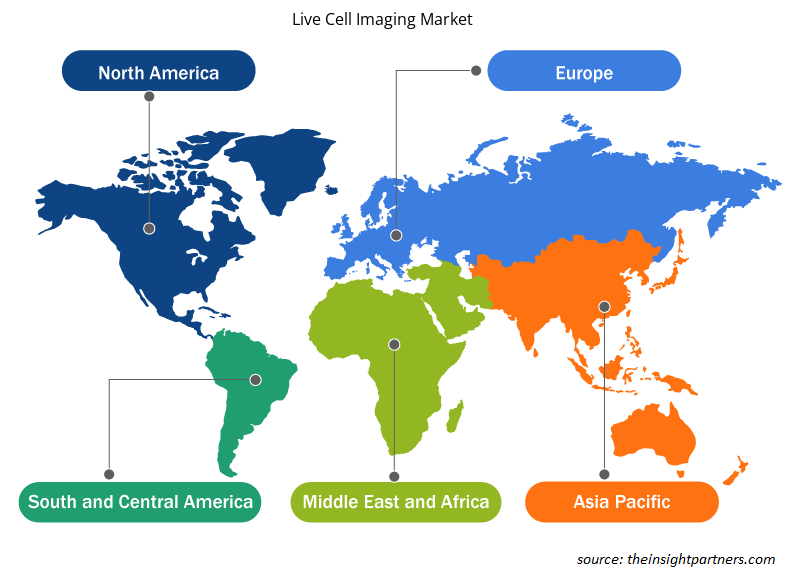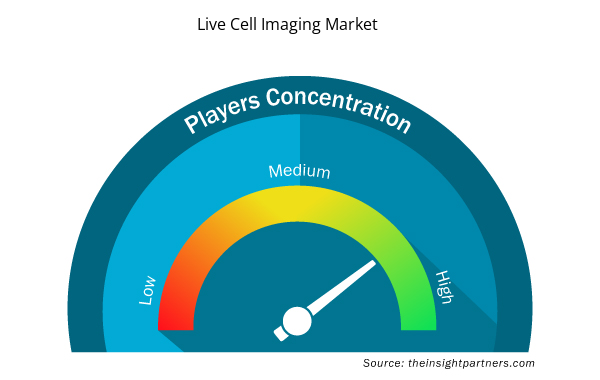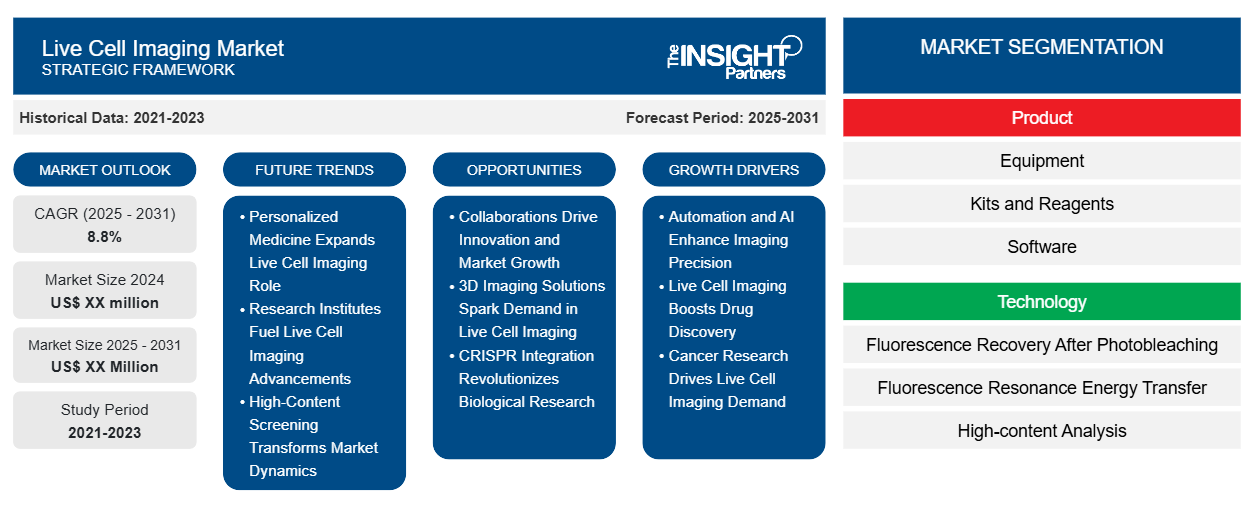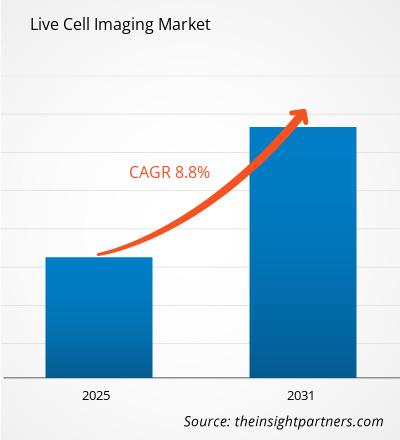Der Markt für Live Cell Imaging wird voraussichtlich von 2023 bis 2031 eine durchschnittliche jährliche Wachstumsrate (CAGR) von 8,8 % verzeichnen, wobei die Marktgröße von XX Millionen US-Dollar im Jahr 2023 auf XX Millionen US-Dollar im Jahr 2031 wachsen wird.
Die Marktforschung für Live Cell Imaging analysiert wichtige Trends und die wichtigsten Marktteilnehmer. Der Bericht umfasst auch Analysen nach Produkt, Technologie, Anwendung, Endbenutzer und Geografie.
Zweck des Berichts
Der Bericht Live Cell Imaging Market von The Insight Partners zielt darauf ab, die aktuelle Situation und das zukünftige Wachstum sowie die wichtigsten treibenden Faktoren, Herausforderungen und Chancen zu beschreiben. Dies wird verschiedenen Geschäftspartnern Einblicke geben, wie zum Beispiel:
- Technologieanbieter/-hersteller: Um die sich entwickelnde Marktdynamik zu verstehen und die potenziellen Wachstumschancen zu kennen, damit sie fundierte strategische Entscheidungen treffen können.
- Investoren: Durchführung einer umfassenden Trendanalyse hinsichtlich der Marktwachstumsrate, der finanziellen Marktprognosen und der Chancen entlang der Wertschöpfungskette.
- Regulierungsbehörden: Zur Regulierung von Richtlinien und Überwachungsaktivitäten auf dem Markt mit dem Ziel, Missbrauch zu minimieren, das Vertrauen der Anleger zu bewahren und die Integrität und Stabilität des Marktes aufrechtzuerhalten.
Live Cell Imaging Marktsegmentierung
Produkt
- Ausrüstung
- Kits und Reagenzien
- Software
- Verbrauchsmaterial
Technologie
- Fluoreszenzwiederherstellung nach Photobleichung
- Fluoreszenz-Resonanz-Energie-Transfer
- High-Content-Analyse
- Fluoreszenz-in-situ-Hybridisierung
- Sonstiges
Anwendung
- Arzneimittelforschung
- Zellbiologie
- Entwicklungsbiologie
- Stammzellen
- Sonstiges
Endbenutzer
- Pharma- und Biotechnologieunternehmen
- Krankenhäuser
- Diagnostische Labore
- Sonstiges
Endbenutzer
- Pharma- und Biotechnologieunternehmen
- Krankenhäuser
- Diagnostische Labore
- Sonstiges
Passen Sie diesen Bericht Ihren Anforderungen an
Sie erhalten kostenlos individuelle Anpassungen an jedem Bericht, einschließlich Teilen dieses Berichts oder einer Analyse auf Länderebene, eines Excel-Datenpakets sowie tolle Angebote und Rabatte für Start-ups und Universitäten.
- Holen Sie sich die wichtigsten Markttrends aus diesem Bericht.Dieses KOSTENLOSE Beispiel umfasst eine Datenanalyse von Markttrends bis hin zu Schätzungen und Prognosen.
Wachstumstreiber auf dem Live Cell Imaging-Markt
- Automatisierung und KI verbessern die Bildgenauigkeit: Verbesserte aktuelle Trends in den Bereichen Automatisierung und künstliche Intelligenz verbessern die Bildgenauigkeit weiter. Diese wird durch die kontinuierliche Entwicklung hochauflösender Bildgebungssysteme und immer modernerer Techniken wie Fluoreszenzmikroskopie für genauere Zellanalysen zur Unterstützung der Arzneimittelentdeckung und Krankheitsforschung wiederbelebt. Daher konzentrieren sich Forscher auf zelluläre Erkenntnisse in Echtzeit, die das globale Marktwachstum ankurbeln, das durch die Nachfrage nach Spitzentechnologien angetrieben wird, die ihren Marktanteil stärken und das Gesicht der wissenschaftlichen Forschung weltweit verändern.
- Live Cell Imaging fördert die Arzneimittelforschung: Die zunehmende Nutzung dieser Technologie bei der Arzneimittelforschung und -entwicklung ist einer der Haupttreiber für das Wachstum des Live Cell Imaging-Marktes. Sie ermöglicht die Visualisierung zellulärer Reaktionen in Echtzeit, was eine der wesentlichen Voraussetzungen für die Beurteilung der Wirksamkeit und Toxizität von Arzneimitteln ist. Marktanalysen zeigen, dass Pharmaunternehmen erheblich in Live Cell Imaging investiert haben, um die Entwicklung zu beschleunigen und bessere Behandlungsergebnisse zu erzielen. Da die personalisierte Medizin an Bedeutung gewonnen hat, ist der Markt recht groß und ermöglicht es Live Cell Imaging, eine positive Rolle bei der Gestaltung der zukünftigen globalen Entwicklungen und Innovationen im Gesundheitswesen zu spielen.
- Krebsforschung treibt Nachfrage nach Live-Cell-Imaging: Live-Cell-Imaging gewinnt in Krebsstudien an Bedeutung, um Tumorwachstum, Metastasierung und Zellverhalten zu verstehen. Die Nachfrage nach dieser Technik wird daher durch die Überwachung der Wechselwirkungen zwischen Krebszellen und der Mikroumgebung steigen. Die zunehmende Einführung der Präzisionsonkologie fördert laut Marktberichten die Marktgröße. Forscher zielen auf diese Techniken ab, um gezieltere Krebstherapien zu entwickeln, die Markttrends stark verändern und Forschungsinstituten und Gesundheitsdienstleistern weltweit höhere Marktanteile bescheren.
Zukünftige Trends auf dem Live Cell Imaging-Markt
- Personalisierte Medizin erweitert Rolle der Live-Cell-Bildgebung: Die Live-Cell-Bildgebung ist aufgrund ihrer zunehmenden Anwendung in der Diagnostik und Therapie Teil der personalisierten Medizin geworden. Fortschrittliche Bildgebungstechniken bieten individualisierte Behandlungen durch tiefere Einblicke in das Zellverhalten verschiedener Patienten. Die aktuellen Markttrends werden von Anpassungen durch Strategieänderungen der wichtigsten Akteure im Bereich zielgerichteter Therapien dominiert. Die SWOT-Analyse unterstreicht die Wachstumschancen in diesem speziellen Sektor, obwohl die hohen Investitionskosten weiterhin eine Herausforderung darstellen. Die PEST-Analyse besteht weiterhin darauf, dass günstige demografische Veränderungen die Nachfrage weiterhin stützen werden.
- Forschungsinstitute treiben Fortschritte bei der Bildgebung lebender Zellen voran: Das PESTEL/STRATEGISCHE RAHMENWERK: Lehr- und Forschungsinstitute werden immer geschickter darin, Technologien zur Bildgebung lebender Zellen als Input für die weitere Forschung in Biologie und Medizin einzusetzen. Dies ist auf die Zusammenarbeit mit Branchenführern und hochmodernen Bildgebungsplattformen zurückzuführen. Laut SWOT-Analyse ist akademische Innovation eine Stärke, während das Fehlen eines angemessenen Budgets als Schwäche gilt. Laut PEST-Analyse werden die Wachstumsfaktoren von der Regierung gut finanziert und genießen starke politische Unterstützung. Infolgedessen haben Investitionen in die Forschung durch solche Institutionen dazu geführt, dass die Hauptakteure begonnen haben, ihre Marktstrategien anzupassen, um diesen Bildungsbedürfnissen gerecht zu werden.
- High-Content-Screening verändert die Marktdynamik: High-Content-Screening wird im Markt für Live Cell Imaging zunehmend eingesetzt, da es das Potenzial hat, große Datensätze aus Live-Zellexperimenten zu analysieren. Es hat auch die Marktdynamik verändert, wobei die wichtigsten Akteure HCS-basierte Marktstrategien anwenden, um effiziente Forschung aufzubauen. Stärken werden durch SWOT-Analysen durch Hochdurchsatz-Datenerfassung hervorgehoben, trotz der Herausforderungen bei der Dateninterpretation. Laut PEST-Analyse treiben die wachsende staatliche und institutionelle Finanzierung und die Nachfrage nach dieser Anwendung in akademischen und pharmazeutischen Sektoren die Marktakzeptanz voran.
Marktchancen für Live Cell Imaging
- Kooperationen fördern Innovation und Marktwachstum: Die Zusammenarbeit zwischen Forschungsinstituten und Unternehmen in verschiedenen Regionen entwickelt sich zu einem entscheidenden Treiber im Markt für Live Cell Imaging. Wettbewerbsanalysen haben ergeben, dass 38 % der nordamerikanischen und europäischen Forschungszentren derzeit an Projekten mit Live Cell Imaging zusammenarbeiten, die Innovation und Wachstum fördern. Dieser Trend bietet Marktführern die Möglichkeit, ihre jeweilige Präsenz auszubauen und maßgeschneiderte Lösungen für die Anforderungen gemeinsamer Forschung zu entwickeln. Diese Partnerschaften sind globaler Natur und verändern das Gesicht der Branche, insbesondere in Wachstumsregionen wie dem asiatisch-pazifischen Raum.
- 3D-Bildgebungslösungen wecken Nachfrage im Bereich der Bildgebung lebender Zellen: Hochauflösende, fortschrittliche 3D-Bildgebungslösungen, insbesondere für komplexe Zellstrukturen und Gewebe, sind auf dem Markt für Bildgebung lebender Zellen stark gefragt. Dies eröffnet Unternehmen, die 3D-spezifische Bildgebungsprodukte entwickeln, große Chancen. Die Aussichten der Technologie gewinnen auch in Europa an Aufmerksamkeit, wo der Schwerpunkt auf Präzisionsforschung die gesamte Branchenlandschaft dort revolutioniert.
- CRISPR-Integration revolutioniert die biologische Forschung: Die Integration der Bildgebung lebender Zellen mit der CRISPR-Genbearbeitung revolutioniert die biologische Forschung und bietet erhebliche Wachstumschancen. Dies führt zu einem positiven Wettbewerbsumfeld für Unternehmen, die in die Integration mit den Schlüsselregionen Europa und Asien-Pazifik investieren.
Regionale Einblicke in den Live Cell Imaging-Markt
Die regionalen Trends und Faktoren, die den Live Cell Imaging-Markt während des Prognosezeitraums beeinflussen, wurden von den Analysten von Insight Partners ausführlich erläutert. In diesem Abschnitt werden auch die Marktsegmente und die Geografie des Live Cell Imaging-Marktes in Nordamerika, Europa, im asiatisch-pazifischen Raum, im Nahen Osten und Afrika sowie in Süd- und Mittelamerika erörtert.

- Erhalten Sie regionale Daten zum Live Cell Imaging-Markt
Umfang des Marktberichts zur Bildgebung lebender Zellen
| Berichtsattribut | Details |
|---|---|
| Marktgröße im Jahr 2023 | XX Millionen US-Dollar |
| Marktgröße bis 2031 | XX Millionen US-Dollar |
| Globale CAGR (2023 - 2031) | 8,8 % |
| Historische Daten | 2021-2022 |
| Prognosezeitraum | 2024–2031 |
| Abgedeckte Segmente | Nach Produkt
|
| Abgedeckte Regionen und Länder | Nordamerika
|
| Marktführer und wichtige Unternehmensprofile |
|
Dichte der Marktteilnehmer für Live Cell Imaging: Deren Auswirkungen auf die Geschäftsdynamik
Der Markt für Live Cell Imaging wächst rasant, angetrieben durch die steigende Nachfrage der Endnutzer aufgrund von Faktoren wie sich entwickelnden Verbraucherpräferenzen, technologischen Fortschritten und einem größeren Bewusstsein für die Vorteile des Produkts. Mit steigender Nachfrage erweitern Unternehmen ihr Angebot, entwickeln Innovationen, um die Bedürfnisse der Verbraucher zu erfüllen, und nutzen neue Trends, was das Marktwachstum weiter ankurbelt.
Die Marktteilnehmerdichte bezieht sich auf die Verteilung von Firmen oder Unternehmen, die in einem bestimmten Markt oder einer bestimmten Branche tätig sind. Sie gibt an, wie viele Wettbewerber (Marktteilnehmer) in einem bestimmten Marktraum im Verhältnis zu seiner Größe oder seinem gesamten Marktwert präsent sind.
Die wichtigsten auf dem Live Cell Imaging-Markt tätigen Unternehmen sind:
- Thermo Fisher Scientific Inc.
- PerkinElmer Inc.
- Allgemeine Elektrik
- Olympus Corporation
- BioTek Instruments, Inc.
Haftungsausschluss : Die oben aufgeführten Unternehmen sind nicht in einer bestimmten Reihenfolge aufgeführt.

- Überblick über die wichtigsten Akteure auf dem Live Cell Imaging-Markt
Wichtige Verkaufsargumente
- Umfassende Abdeckung: Der Bericht deckt die Analyse von Produkten, Diensten, Typen und Endbenutzern des Live Cell Imaging-Marktes umfassend ab und bietet einen ganzheitlichen Überblick.
- Expertenanalyse: Der Bericht basiert auf dem umfassenden Verständnis von Branchenexperten und Analysten.
- Aktuelle Informationen: Der Bericht stellt durch die Abdeckung aktueller Informationen und Datentrends Geschäftsrelevanz sicher.
- Anpassungsoptionen: Dieser Bericht kann angepasst werden, um spezifische Kundenanforderungen zu erfüllen und die Geschäftsstrategien optimal anzupassen.
Der Forschungsbericht zum Live Cell Imaging-Markt kann daher dabei helfen, die Branchensituation und Wachstumsaussichten zu entschlüsseln und zu verstehen. Obwohl es einige berechtigte Bedenken geben kann, überwiegen die allgemeinen Vorteile dieses Berichts tendenziell die Nachteile.
- Historische Analyse (2 Jahre), Basisjahr, Prognose (7 Jahre) mit CAGR
- PEST- und SWOT-Analyse
- Marktgröße Wert/Volumen – Global, Regional, Land
- Branche und Wettbewerbsumfeld
- Excel-Datensatz


- Artificial Intelligence in Healthcare Diagnosis Market
- Clinical Trial Supplies Market
- Pressure Vessel Composite Materials Market
- Architecture Software Market
- Mobile Phone Insurance Market
- Vision Guided Robotics Software Market
- Saudi Arabia Drywall Panels Market
- Real-Time Location Systems Market
- Broth Market
- Hand Sanitizer Market

Report Coverage
Revenue forecast, Company Analysis, Industry landscape, Growth factors, and Trends

Segment Covered
This text is related
to segments covered.

Regional Scope
North America, Europe, Asia Pacific, Middle East & Africa, South & Central America

Country Scope
This text is related
to country scope.
Häufig gestellte Fragen
The report can be delivered in PDF/PPT format; we can also share excel dataset based on the request.
Some of the customization options available based on request are additional 3-5 company profiles and country-specific analysis of 3-5 countries of your choice. Customizations are to be requested/discussed before making final order confirmation, as our team would review the same and check the feasibility.
Key companies in this market are: Thermo Fisher Scientific Inc, PerkinElmer Inc, General Electric, Olympus Corporation, BioTek Instruments Inc, Molecular Devices LLC, CYTOSKELETON INC, Bruker, Nikon Instruments Inc
The Live Cell Imaging Market is expected to register a CAGR of 8.8% from 2023-2031.
Key future trends in this market are - Advancements in microscopy technologies, Growth in drug discovery, Demand for real-time cell analysis
The major factors impacting the Live Cell Imaging Market are: Technological Advancements in Imaging Systems, Rising Demand in Drug Discovery and Development, and Growing Application in Cancer Research
Trends and growth analysis reports related to Life Sciences : READ MORE..
The List of Companies
1. Thermo Fisher Scientific Inc.
2. PerkinElmer Inc.
3. General Electric
4. Olympus Corporation
5. BioTek Instruments, Inc.
6. Molecular Devices, LLC.
7. CYTOSKELETON, INC.
8. Bruker
9. Nikon Instruments Inc.
10. Merck KGaA
11. Keyence Corporation
12. NanoLive SA
13. Sony Biotechnology Inc.
14. Phase Focus
15. Logos Biosystems (Aligned Genetics, Inc.)
The Insight Partners performs research in 4 major stages: Data Collection & Secondary Research, Primary Research, Data Analysis and Data Triangulation & Final Review.
- Data Collection and Secondary Research:
As a market research and consulting firm operating from a decade, we have published and advised several client across the globe. First step for any study will start with an assessment of currently available data and insights from existing reports. Further, historical and current market information is collected from Investor Presentations, Annual Reports, SEC Filings, etc., and other information related to company’s performance and market positioning are gathered from Paid Databases (Factiva, Hoovers, and Reuters) and various other publications available in public domain.
Several associations trade associates, technical forums, institutes, societies and organization are accessed to gain technical as well as market related insights through their publications such as research papers, blogs and press releases related to the studies are referred to get cues about the market. Further, white papers, journals, magazines, and other news articles published in last 3 years are scrutinized and analyzed to understand the current market trends.
- Primary Research:
The primarily interview analysis comprise of data obtained from industry participants interview and answers to survey questions gathered by in-house primary team.
For primary research, interviews are conducted with industry experts/CEOs/Marketing Managers/VPs/Subject Matter Experts from both demand and supply side to get a 360-degree view of the market. The primary team conducts several interviews based on the complexity of the markets to understand the various market trends and dynamics which makes research more credible and precise.
A typical research interview fulfils the following functions:
- Provides first-hand information on the market size, market trends, growth trends, competitive landscape, and outlook
- Validates and strengthens in-house secondary research findings
- Develops the analysis team’s expertise and market understanding
Primary research involves email interactions and telephone interviews for each market, category, segment, and sub-segment across geographies. The participants who typically take part in such a process include, but are not limited to:
- Industry participants: VPs, business development managers, market intelligence managers and national sales managers
- Outside experts: Valuation experts, research analysts and key opinion leaders specializing in the electronics and semiconductor industry.
Below is the breakup of our primary respondents by company, designation, and region:

Once we receive the confirmation from primary research sources or primary respondents, we finalize the base year market estimation and forecast the data as per the macroeconomic and microeconomic factors assessed during data collection.
- Data Analysis:
Once data is validated through both secondary as well as primary respondents, we finalize the market estimations by hypothesis formulation and factor analysis at regional and country level.
- Macro-Economic Factor Analysis:
We analyse macroeconomic indicators such the gross domestic product (GDP), increase in the demand for goods and services across industries, technological advancement, regional economic growth, governmental policies, the influence of COVID-19, PEST analysis, and other aspects. This analysis aids in setting benchmarks for various nations/regions and approximating market splits. Additionally, the general trend of the aforementioned components aid in determining the market's development possibilities.
- Country Level Data:
Various factors that are especially aligned to the country are taken into account to determine the market size for a certain area and country, including the presence of vendors, such as headquarters and offices, the country's GDP, demand patterns, and industry growth. To comprehend the market dynamics for the nation, a number of growth variables, inhibitors, application areas, and current market trends are researched. The aforementioned elements aid in determining the country's overall market's growth potential.
- Company Profile:
The “Table of Contents” is formulated by listing and analyzing more than 25 - 30 companies operating in the market ecosystem across geographies. However, we profile only 10 companies as a standard practice in our syndicate reports. These 10 companies comprise leading, emerging, and regional players. Nonetheless, our analysis is not restricted to the 10 listed companies, we also analyze other companies present in the market to develop a holistic view and understand the prevailing trends. The “Company Profiles” section in the report covers key facts, business description, products & services, financial information, SWOT analysis, and key developments. The financial information presented is extracted from the annual reports and official documents of the publicly listed companies. Upon collecting the information for the sections of respective companies, we verify them via various primary sources and then compile the data in respective company profiles. The company level information helps us in deriving the base number as well as in forecasting the market size.
- Developing Base Number:
Aggregation of sales statistics (2020-2022) and macro-economic factor, and other secondary and primary research insights are utilized to arrive at base number and related market shares for 2022. The data gaps are identified in this step and relevant market data is analyzed, collected from paid primary interviews or databases. On finalizing the base year market size, forecasts are developed on the basis of macro-economic, industry and market growth factors and company level analysis.
- Data Triangulation and Final Review:
The market findings and base year market size calculations are validated from supply as well as demand side. Demand side validations are based on macro-economic factor analysis and benchmarks for respective regions and countries. In case of supply side validations, revenues of major companies are estimated (in case not available) based on industry benchmark, approximate number of employees, product portfolio, and primary interviews revenues are gathered. Further revenue from target product/service segment is assessed to avoid overshooting of market statistics. In case of heavy deviations between supply and demand side values, all thes steps are repeated to achieve synchronization.
We follow an iterative model, wherein we share our research findings with Subject Matter Experts (SME’s) and Key Opinion Leaders (KOLs) until consensus view of the market is not formulated – this model negates any drastic deviation in the opinions of experts. Only validated and universally acceptable research findings are quoted in our reports.
We have important check points that we use to validate our research findings – which we call – data triangulation, where we validate the information, we generate from secondary sources with primary interviews and then we re-validate with our internal data bases and Subject matter experts. This comprehensive model enables us to deliver high quality, reliable data in shortest possible time.


 Holen Sie sich ein kostenloses Muster für diesen Bericht
Holen Sie sich ein kostenloses Muster für diesen Bericht